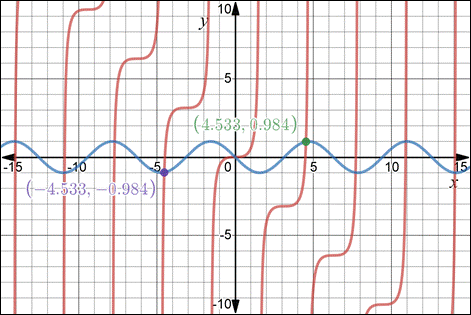
To calculate: The roots of the curve,
y=−sinx .
Answer to Problem 30E
The roots are
x1≈4.5
x2≈4.493613
x3≈4.493409 .
Explanation of Solution
Given information:
The infinitely many lines that are tangent to the curve y=−sinx passes through the origin.
Formula used:
Newton’s Method:
We seek a solution of f(x)=0 , starting from an initial estimate x=x1 .
For x=xn , compute the next approximation xn+1 by
xn+1=xn−f(xn)f'(xn) and so on.
Equation of tangent line : y−y1=m(x−x1)
Slope of the tangent line : derivative of the function.
Calculation:
Consider the curve ,
y=−sinx
Now,
f(x)=−sinxf'(x)=−cosx
The line passes through the origin
=y−y1=m(x−x1)=y−0=m(x−0)=y=mx (i)
While the tangent will touch the curve at some point. Let the x -coordinate be a.
Therefore , putting x-coordinate in equation y=−sinx we get,
y=−sina .
The point at which tangent touches the curve is (a,−sina) .
Put it in equation (i)
=−sina=ma
Slope of the tangent :-
m=−cosx .
At point (a,−sina) the slope will be
m=−cosa
We get ,
=−sina=(−cosa)a=−sina−cosa=a=sinacosa=a=tana=a=tana−a=0
Sketching the graph of function y=−sinx and y=tanx−x . We observe the graph is symmetric.

Figure 1.
Hence, we get the slope of the curve is y=tanx−x . In other words g(x)=tanx−x used to find out roots using Newton’s Method.
Therefore,
g(x)=tanx−x and
g'(x)=sec2(x)−1
Now, let initial approximation be x1=4.5
For n=1
x2=x1−g(x1)g'(x1)
x2=x1−tanx1−x1sec2(x1)−1
x2=(4.5)−tan(4.5)−4.5[sec(4.5)]2−1x2=(4.5)−4.637332055−4.522.5048486−1
x2=4.5−0.13733205521.5048486x2=4.5−0.006386097273x2=4.493613903
The second approximation is x2=4.493613 .
For n=2
x3=x2−g(x2)g'(x2)
x3=x2−tanx2−x2sec2(x2)−1
x3=(4.493613)−tan(4.493613)−4.493613[sec(4.493613)]2−1x3=(4.493613)−4.497726612−4.49361321.22954465−1
x3=4.493613−0.00411361220.22954465x3=4.493613−0.0002033467422x3=4.493409653
The third approximation is x3=4.493409 .
Hence , the roots of the curve are :-
x1≈4.5
x2≈4.493613
x3≈4.493409
Chapter 4 Solutions
Single Variable Calculus: Concepts and Contexts, Enhanced Edition
- A 20 foot ladder rests on level ground; its head (top) is against a vertical wall. The bottom of the ladder begins by being 12 feet from the wall but begins moving away at the rate of 0.1 feet per second. At what rate is the top of the ladder slipping down the wall? You may use a calculator.arrow_forwardExplain the focus and reasons for establishment of 12.4.1(root test) and 12.4.2(ratio test)arrow_forwarduse Integration by Parts to derive 12.6.1arrow_forward
- Explain the relationship between 12.3.6, (case A of 12.3.6) and 12.3.7arrow_forwardExplain the key points and reasons for the establishment of 12.3.2(integral Test)arrow_forwardUse 12.4.2 to determine whether the infinite series on the right side of equation 12.6.5, 12.6.6 and 12.6.7 converges for every real number x.arrow_forward
- use Corollary 12.6.2 and 12.6.3 to derive 12.6.4,12.6.5, 12.6.6 and 12.6.7arrow_forwardExplain the focus and reasons for establishment of 12.5.1(lim(n->infinite) and sigma of k=0 to n)arrow_forwardExplain the focus and reasons for establishment of 12.5.3 about alternating series. and explain the reason why (sigma k=1 to infinite)(-1)k+1/k = 1/1 - 1/2 + 1/3 - 1/4 + .... converges.arrow_forward
 Calculus: Early TranscendentalsCalculusISBN:9781285741550Author:James StewartPublisher:Cengage Learning
Calculus: Early TranscendentalsCalculusISBN:9781285741550Author:James StewartPublisher:Cengage Learning Thomas' Calculus (14th Edition)CalculusISBN:9780134438986Author:Joel R. Hass, Christopher E. Heil, Maurice D. WeirPublisher:PEARSON
Thomas' Calculus (14th Edition)CalculusISBN:9780134438986Author:Joel R. Hass, Christopher E. Heil, Maurice D. WeirPublisher:PEARSON Calculus: Early Transcendentals (3rd Edition)CalculusISBN:9780134763644Author:William L. Briggs, Lyle Cochran, Bernard Gillett, Eric SchulzPublisher:PEARSON
Calculus: Early Transcendentals (3rd Edition)CalculusISBN:9780134763644Author:William L. Briggs, Lyle Cochran, Bernard Gillett, Eric SchulzPublisher:PEARSON Calculus: Early TranscendentalsCalculusISBN:9781319050740Author:Jon Rogawski, Colin Adams, Robert FranzosaPublisher:W. H. Freeman
Calculus: Early TranscendentalsCalculusISBN:9781319050740Author:Jon Rogawski, Colin Adams, Robert FranzosaPublisher:W. H. Freeman
 Calculus: Early Transcendental FunctionsCalculusISBN:9781337552516Author:Ron Larson, Bruce H. EdwardsPublisher:Cengage Learning
Calculus: Early Transcendental FunctionsCalculusISBN:9781337552516Author:Ron Larson, Bruce H. EdwardsPublisher:Cengage Learning





